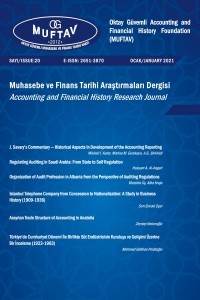Evolution of Professional Skepticism and Its Thought Background(*)
With the advent of The Philosophy of Auditing by Mautz and Sharaf (1961) which became a cornerstone on the path to establish auditing theory, auditor’s Skepticism, which is called Professional Skepticism (PS) in audit standards began to gradually permeate professionals’ mind sets. Cohen commission report (1978) published in US had introduced the auditor’s posture of neutrality to be sought, and it explored the ways to fill the “expectation gap” hindrances. Exposure of PS as a term had been initiated from US SAS 53 (1988) and, among others, the two POB reports (1993 and 2000). Those are the initial professional publications to be recalled in order to pursue fraud risk-averse audit, availing the effect of PS which is applicable to audit. This article is mostly devoted to shed light on the evolution of PS which could be observed historically in critical audit publications. In addition, it is the author’s intention to draw attention to the “healthy PS” which could be understood with the context of audit standard that typically asserts auditor’s neutrality, i.e. “the auditor neither assumes that management is dishonest nor assumes unquestioned honesty” (US AU230 ¶09). That is, as practices to be understood between the outcomes of idealism and pragmatism, auditors eventually have to observe reasonableness and they should do neither run the risk of α (risk of losing efficiency), norβ (risk of losing effectiveness) . At present of 21st century, however, neutrality could no longer be conceived as auditor’s ideal posture, and professionals are now required to have more rigorous attitude, i.e., Presumptive Doubt (PD) foundation on applying PS. Thought background of PS has been evolved constantly to date.
Keywords:
Professional Skepticism (PS), Presumptive Doubt (PD), Neutrality, Reasonable Assurance, Belief Accumulation (anchoring), β Risk α Risk.,
- ISSN: 2146-4928
- Yayın Aralığı: Yılda 2 Sayı
- Başlangıç: 2011
- Yayıncı: Oktay Güvemli Muhasebe ve Finans Tarihi Vakfı (MUFTAV)
Sayıdaki Diğer Makaleler
Miguel GONÇALVES, Maria Da Conceição MARQUES
Manas Destanı’nda İktisadi Hayat ve Muhasebe Bulguları
Türk Ticaret Kanunlarının Türk Muhasebe Düşüncesinin Gelişmesindeki Etkileri
Oktay GÜVEMLİ, Batuhan GÜVEMLİ
Alan SANGSTER, Ellie Franklin, Dee Alwis, Jo Abdul-Rahim, Greg STONER
17. Yüzyılda Anadolu’da Kadın Vakıfları ve Muhasebesi: Tokat Hatuniye Vakıf Muhasebesi Örneği
Fatih Coşkun ERTAŞ, Şaziye ULUBAŞ ŞAHİN
Temin Edilebilecek Muhasebe, Finansman ve Muhasebe Tarihi Kitapları
